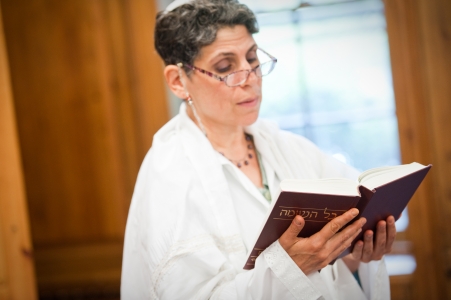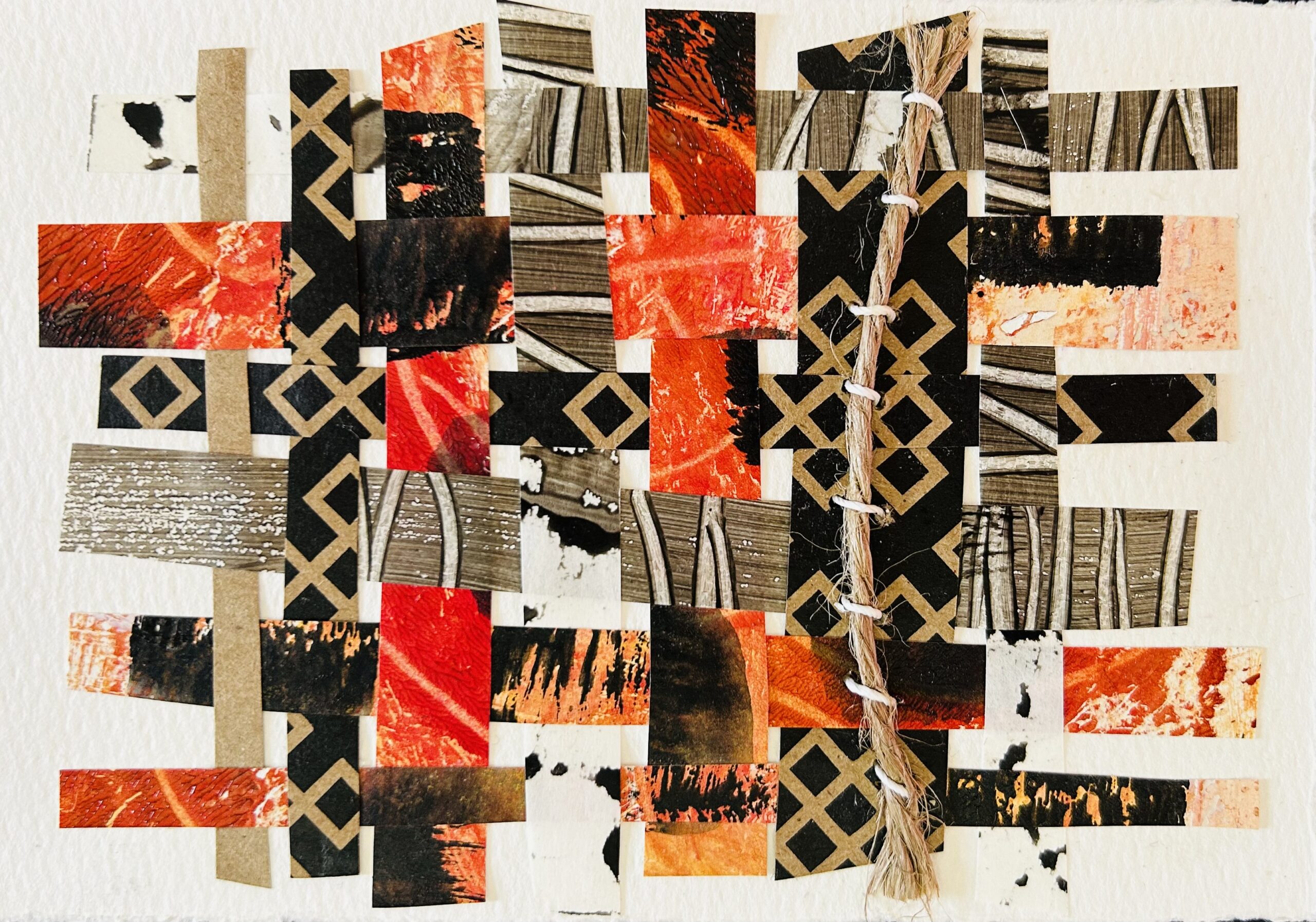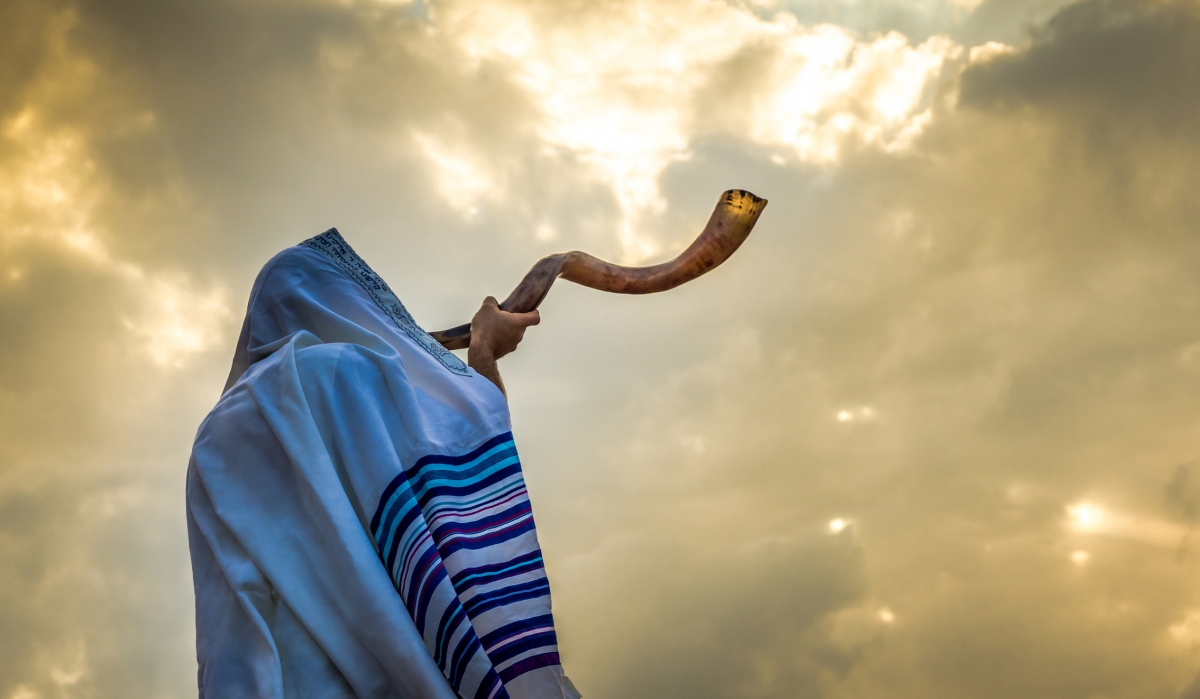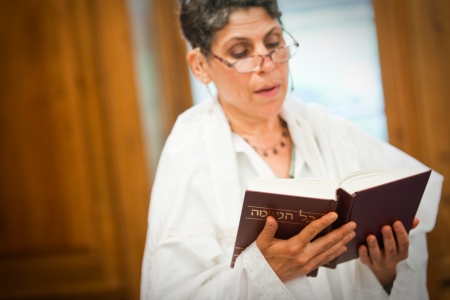The Avodah service is the entirety of our Musaf on Yom Kippur morning. (Instead of a separate Eleh Ezkerah, we extend the Yizkor a little to include martyrs.)
After the Sefer Torah is returned to the aron, the rabbi begins a solemn drumming on his pulpit and explains very briefly that we’re entering the realm of the High Priest and the Holy of Holies. Participants will be offered a small sachet with (a reconstruction of) the scent of the Bet Hamikdash and a small stone. They can smell the sachet whenever they wish during the service to evoke the holy ambience. At the end, they’ll be asked to give the stone away into a bowl as a symbol of giving away our sins, or of giving our selves and our souls over to God, or whatever symbolism is meaningful to them.
There’s some preparation and set-up needed. We buy a scent called “Ketoret” and put a drip on a piece of tissue paper, that’s put in one of those little mesh bags some people use to hold candy tossed at a bar/bat mitzvah. We place a big fishbowl partly filled with water on a stand in the center aisle. Because people will put the stones in the bowl, we put some clear glass marbles at the bottom so that the first stones don’t crack the glass.
A reader reads:
(pp. 845–847 in Kol Haneshamah Mahzor)
G-d’s world is great and holy. Among the holy lands in the world is the Holy Land of Israel. In the land of Israel the holiest city is Jerusalem. In Jerusalem the holiest place was the Temple, and in the Temple the holiest spot was the holy of holies.
There are 70 peoples in the world. Among these holy peoples is the people of Israel. The holiest of the people of Israel is the tribe of Levi. In the tribe of Levi the holiest are the priests. Among the priests, the holiest was the high priest.
Of the days of the year, the holidays are holy. Higher than these is the holiness of the Sabbath. Among Sabbaths the holiest is the Day of Atonement (Yom Kippur), the Sabbath of Sabbaths.
There are 70 languages in the world. Among the holy languages is the holy language of Hebrew. Holier than all else in this language is the holy Torah, and in the Torah the holiest part is the Ten Commandments. In the Ten Commandments the holiest of all words is the Name of God.
And once during the year, at a certain hour, these four supreme sanctities of the world were joined with one another. That was on the Day of Atonement, when the high priest would enter the holy of holies and there utter the Name of G-d.
And because this hour was beyond measure holy and awesome, it was the time of utmost peril not only for the high priest but for the whole of Israel. For if, in this hour, there had, God forbid, entered the mind of the high priest a false or sinful thought, the entire world would have been destroyed.
Every spot where a person stands and looks toward heaven is a holy of holies. Every day of one’s life is a Day of Atonement and every person is a high priest, and every word that a person utters in holiness and purity is the Name of God.
(Based on a passage in “The Dybbuk” by S. An-Ski)
Rabbi leads first meditation
(this version is two adaptation stages away from a meditation by Gail Albert—can be further adapted)
Take up the sachet with the k’toret scent of the ancient Temple. Smell the ancientness. Smell Divine Mystery, imagine the ancient Holy of Holies filled with that smell, that mystery (let it take you out of mind, and into heart). Let it remind you (or reheart you) of the EVER-PRESENT, sensible, smellable, tastable, seeable – “taste and see how good the ONE can be,” yet also, fundamentally, always unknowable, always becoming, “I WILL BE WHAT I WILL BE – EHYEH ASHER EHYEH” filling the universe with the unwinding patterns of cause and effect, of randomness and chaos, choice and love. Be in don’t-know mind. Be in that Presence. Be called by that Presence. Respond “Hineni – Here I am.”
Choir sings one of the following:
All Babies
by Sinead O’Connor
(you can hear it at https://www.youtube.com/watch?v=XNa2UPcN2vw)
All babies are born saying God’s name
Over and over,
All born singing God’s name
All babies are flown from the Universe
From there they’re lifted by the hands of angels
God gives them the stars to use as ladders
She hears their calls
She is mother and father
All babies are born out of great pain
Over and over
All born into great pain
All babies are crying
For no-one remembers God’s name
All babies are born saying God’s name
Over and over,
All born singing God’s name
All babies are flown from the Universe
From there they’re lifted by the hands of angels
God gives them the stars to use as ladders
She hears their calls
She is mother and father
All babies are born out of great pain
Over and over
All born into great pain
All babies are crying
For no-one remembers God’s name
There’s only love
There’s only love
There’s only love in this world
There’s only love
There’s only love
There’s only love in this world
Hallelujah
by Leonard [no-glossaryCohen[/no-glossary]
You say I took the name in vain
I don’t even know the name
But if I did, well really, what’s it to you?
There’s a blaze of light
In every word
It doesn’t matter which you heard
The holy or the broken Hallelujah
Hallelujah, Hallelujah
Hallelujah, Hallelujah
I did my best, it wasn’t much
I couldn’t feel, so I tried to touch
I’ve told the truth, I didn’t come to fool you
And even though
It all went wrong
I’ll stand before the Lord of Song
With nothing on my tongue but Hallelujah
Hallelujah, Hallelujah
Hallelujah, Hallelujah
Rabbi leads second meditation
(this version is again two adaptations away from one by Gail Albert)
Take up the stone. What’s it feel like? cool? warm? smooth? dead weight? solid? lovely?… there might be many aspects to a stone.
We ourselves are said to be hewn from God, the Rock of Ages, the Rock of our salvation, the One with no image.
And some part of us comes from the Earth, just like the stone.
Pay attention to your breath a moment. Like the stone with its many aspects, you, too, are made of many aspects: earth and air, mixing and changing places without your needing to control it. Inside and out mixing and making something uniquely you.
In our multiple aspects as the hewn Rock we are, we confess that we sometimes get confused. We sometimes seek excessive solidity, denying the uncontrollable mystery of I WILL BE, the everbecoming Life of all Worlds. We try to control others’ lives, putting ourselves in the service of that great seeker of solidity, the Pharaoh entombed in pyramids, rather than of God.
Take a moment to appreciate again the many aspects of the stone in your hand.
Congregation chants Ashamnu
(based on David R. Slavitt translation of “A Crown for the King,” section 34)
We have abrogated your commandments
We have broken your law
We have closed our hearts
We have dirtied out mouths with slander
We have exercised bad judgment.
We have failed those how trusted us
We have gossiped
We have harbored grudges
We have ignored your chastisements
We have joked at the wrong time
We have kept still when we should have spoken out
We have lied
We have misled people by telling partial truths
We have nodded in assent to wrongdoing we should have protested.
We have been overbearing
We have been perverse
We have been quarrelsome
We have ridiculed
We have scoffed
We have turned away from the life you have prescribed
We have been unfair.
We have been violent
We have been wicked
We have been execrable
We have yammered when we ought to have been patient
We have zigzagged when the path you set for us was straight and true.
A reader read’s Reb Zalman’s kavannah
(found in the Kol Haneshamah Mahzor, p. 864)
One of the original intents of the Avodah service was to purify the Holy of Holies from pollution—from a hilul hashem—a hole in God’s name. Every time we commit a sin, we make a hole in the Name. (One definition of sin is making a tear in the Divine weave.) By the end of the year, God’s name—our connection to God—is riddled with holes. A new Name is needed. God enters into time to create the possibility of a new name for the next year. This offers us the possibility of creating our own root metaphor for how we interface with God this year.
Congregation joins in an adapted High Priest confession
(Offering the Name/Metaphor, in the spirit of Reb Zalman’s kavannah above, they need to speak this year out loud when we get to “[THE NAME]”):
Please, Hashem, I and my community and the whole human family have failed you, we have done evil, we have evaded responsibility. Please, by your Name, grant atonement for the failures and evils and evasions we have committed in your presence. As it is written in the Torah of your servant, Moses, expressing your glory: “For on this day, God will grant atonement to you, to purify you. From all your failures in the presence of …
[THE NAME]
… you will be pure.
And when we hear the glorious, awesome NAME articulated in the mouths of our holy community, we kneel and prostrate ourselves; we give thanks and acknowledge our SOURCE and say:
בָּרוּךְ שֵׁם כְּבוֹד מַלְכוּתוֹ לְעוֹלָם וָעֶד
BARUH SHEM K’VOD MALHUTO L’OLAM VA’ED
[blessed is the name of Its glorious sovereignty forever!]
Reader or whole congregation reads
Step One: Step of Forgiveness
by Rami Shapiro
Even now the depth of sin escapes me.
There is more darkness than
the feeble candle of forgiveness can erase.
Yet by its light I see my place
where I stand and
where I might next step.
It is enough.
To step one step
to turn one turn
this time
Now.
Yes there is pain.
Yes there is hurt.
And there is redemption.
With the pain.
With the hurt.
There is redemption.
Who can straighten what has been crooked?
I cannot, though I so wish it otherwise.
But otherwise has trapped me too long.
Now is the time of arising.
Now is the time of awakening.
Now is the time of doing:
Not straightening
but no more twisting;
Not forgetting
but at last forgiving.
And to that I say: Amen.
“One step of forgiveness” walking meditation
Congregation walks around outside aisles to the bowl, where they place their stones, giving over to God all that they need to give. During the walking meditation, Choir sings “Hinei Ani” by Shye Ben Tzur (hear recording at https://hazon.bandcamp.com/track/hinei-ani) or “Bilvovi” by Rabbi Yitzchak Hutner, based on a poem by Eleazar Azikri, recorded by Bet Haverim choir on their “Shekhinah’s Crown” CD. You can see a video here: https://www.youtube.com/watch?v=8OQaFL0f1IM. After depositing stone, congregants go back to their seats.
Hinei Ani
by Shye Ben Tzur
הִנֵּה אֲנִי כֻּלִּי שֶׁלְּךָ, עֲשֵׂה בִּי כִּרְצוֹנְךָ,
בָּאְתִּי רֵיק, אֲנִי נִכְנָע, לִבִּי נָתוּן לְחַסְדְךָ.
גַּם אִם הַכֹּל יְשָׁלֵל מִמֶּנִּי, בְּתֹכִי קוֹלְךָ אֶשְׁמַע.
מִן הַכְּאֵב הוּא יָרִימֵנִי, יְמַלְּאֵנִי בְּאַהֲבָה.
Hinei ani, kuli shelha, aseh bi kirtsonha.
bati rek, ani nihna, libi natun l’hasd’ha
gam im hakol y’shalel mimeni, b’tohi kolha eshma
min hak’ev hu yarimeni, y’mal’eni b’ahavah
Here I am, all yours, do with me as you will.
I come emptly, I surrender, my heart is given in your hands.
Even if all is taken from me, Your voice remains inside.
Lifting me from my pain, filling me with love.
Bilvovi
בִּלְבָבִי מִשְׁכַּן אֶבְנֶה לְהַדַר כְּבוֹדוֹ
וּבְמִשְׁכַּן מִזְבֵּחַ אָקִים לְקַרְנֵי הוֹדוֹ
וּלְנֵר תָמִיד אֶקַח לִי אֶת אֵשׁ הַעֲקֵידָה
וּלְקָרְבַּן אַקְרִיב לוֹ אֶת נָפשִׁי הַיְחִידָה
In my heart, I’ll build a Dwelling for God’s beautiful Glory
And in the Dwelling, I’ll raise up an alter with majestic horns
And for an Eternal Light, I’ll take the fire of Isaac’s Binding
And as an offering, I’ll offer my only soul
Congregation recites Priestly Blessing
(We do it in the Italian-inspired Lavy Becker style,with all who wear tallit covering their neighbors with it and all blessing their neighbors.)
Congregation concludes with singing “Hayom”
hayom te’amtsehnu amen
hayom tevarhehnu amen
hayom tegadlehun amen
hayom tidreshehnu letovah amen
hayom tihtevehnu lehayim tovim amen
hayom tishma shav’atehnu amen
hayom tekabel berahamim uveratson et tefilatehnu amen
hayom titmehehnu bimin tsidkehha amen













